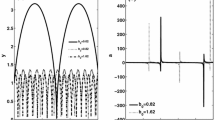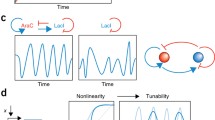Abstract
Discrete mathematical slow oscillatory models are proposed to describe biological interactions between two populations by considering power-law functions. Conditions for slow convergence to the equilibrium point are imposed on model parameters. Moreover, to obtain oscillatory solutions we prove that model exponents may be parameterized by only one parameter. As a by-product, we also discover a family of functions that can be regarded as a two-dimensional generalization of the Schwarzian derivative. Diverse particular model cases are analyzed numerically in order to show orbital solutions. Finally, applications for biochemical and population models are presented.







Similar content being viewed by others
References
Savageau, M.A.: Introduction to S-systems and the underlying power-law formalism. Math. Comput. Model. 11, 546–551 (1988)
Voit, E.O.: Canonical Nonlinear Modeling: S-systems Approach to Understanding Complexity. Van Nostrand Reinhold, New York (1991)
Komarova, S.V., Smith, R.J., Dixon, S.J., Sims, S.M., Wahl, L.M.: Mathematical model predicts a critical role for osteoclast autocrine regulation in the control of bone remodeling. Bone 33(2), 206–215 (2003)
Savageau, M.A., Lomnitz, J.G.: Deconstructing Complex Nonlinear Models in System Design Space In Discrete and Topological Models in Molecular Biology. Springer, Berlin (2014)
Vera, J., Balsa-Canto, E., Wellstead, P., Banga, J.R., Wolkenhauer, O.: Power-law models of signal transduction pathways. Cell Signal. 19(7), 1531–1541 (2007)
Boros, B., Hofbauer, J., Müller, S.: On global stability of the Lotka reactions with generalized mass-action kinetics. Acta Appl. Math. 151(1), 53–80 (2017)
Dancsó, A., Farkas, H., Farkas, M., Szabó, G.: Investigations into a class of generalized two-dimensional Lotka–Volterra schemes. Acta Appl. Math. 23(2), 103–127 (1991)
Hatton, I.A., McCann, K.S., Fryxell, J.M., Davies, T.J., Smerlak, M., Sinclair, A.R., Loreau, M.: The predator-prey power law: biomass scaling across terrestrial and aquatic biomes. Science 349(6252), aac6284 (2015)
Müller, S., Regensburger, G.: Generalized mass action systems: complex balancing equilibria and sign vectors of the stoichiometric and kinetic-order subspaces. SIAM J. Appl. Math. 72, 1926–1947 (2012)
Gupta, A., Banerjee, T., Dutta, P.S.: Increased persistence via asynchrony in oscillating ecological populations with long-range interaction. Phys. Rev. E 96(4), 042202 (2017)
Hopkins, F., Von Brentano, P.: High n-state population and delayed photon emission from beam-foil interaction. J. Phys. B. Atom. Mol. 9(5), 775–778 (1976)
Wiuf, C., Feliu, E.: Power-law kinetics and determinant criteria for the preclusion of multistationarity in networks of interacting species. SIAM J. Appl. Dyn. Syst. 12(4), 1685–1721 (2013)
Wang, Y., Gao, S., Yu, Y., Xu, Z.: The discovery of population interaction with a power law distribution in brain storm optimization. Memet. Comput. 11(1), 65–87 (2019)
Bacheler, N.M., Shertzer, K.W., Cheshire, R.T., MacMahan, J.H.: Tropical storms influence the movement behavior of a demersal oceanic fish species. Sci. Rep. 9(1), 1–3 (2019)
Daido, H.: Discrete-time population dynamics of interacting self-oscillators. Prog. Theor. Phys. 75(6), 1460–1463 (1986)
Kuperman, M.N., Laguna, M.F., Abramson, G., Monjeau, J.A., Lanata, J.L.: Metapopulation oscillations from satiation of predators. Physica A 527(1–8), 121288 (2019)
Mohd, M.H.: Diversity in interaction strength promotes rich dynamical behaviours in a three-species ecological system. Appl. Math. Comput. 353, 243–253 (2019)
Neverova, G.P., Zhdanova, O.L., Ghosh, B., Frisman, E.Y.: Dynamics of a discrete-time stage-structured predator-prey system with Holling type II response function. Nonlinear Dyn. 98(1), 427–446 (2019)
Jana, D.: Chaotic dynamics of a discrete predator-prey system with prey refuge. Appl. Math. Comput. 224, 848–865 (2013)
Lyu., X., Gao, Q., Luo, G., : Dynamic characteristics of a mechanical impact oscillator with a clearance. Int. J. Mech. Sci. 178, 105605 (2020)
Shibata, T.: Global and local structures of oscillatory bifurcation curves. J. Spectr. Theory 9(3), 991–1003 (2019)
Sun, K., Zhang, T., Tian, Y.: Theoretical study and control optimization of an integrated pest management predator–prey model with power growth rate. Math. Biosci. 279, 13–26 (2016)
Tang, S., Tang, B., Wang, A., Xiao, Y.: Holling II predator–prey impulsive semi-dynamic model with complex Poincaré map. Nonlinear Dyn. 81(3), 1575–1596 (2015)
Yin, W., Voit, E.O.: Construction and customization of stable oscillation models in biology. J. Biol. Syst. 16(04), 463–478 (2008)
Hilker, F.M., Liz, E.: Proportional threshold harvesting in discrete-time population models. J. Math. Biol. 79, 1927–1951 (2019)
Izzo, G., Vecchio, A.: A discrete time version for models of population dynamics in the presence of an infection. J. Comput. Appl. Math. 210(1–2), 210–221 (2007)
Zeigler, B.P.: Persistence and patchiness of predator–prey systems induced by discrete event population exchange mechanisms. J. Theor. Biol. 67(4), 687–713 (1977)
Crowe, K.M.: A nonlinear ergodic theorem for discrete systems. J. Math. Biol. 32, 179–191 (1994)
Lewis, S.J.: A note on the strong ergodic theorem of some discrete models. J. Differ. Equ. Appl. 3(1), 55–63 (1997)
Elaydi, S., Sacker, R.: Global stability of periodic orbits of nonautonomous difference equations and populations biology. J. Differ. Equ. 208, 258–273 (2005)
Kon, R.: A note on attenuant cycles of population models with periodic carrying capacity. J. Differ. Equ. Appl. 10(8), 791–793 (2004)
Liz, E.: Local stability implies global stability in some one-dimensional discrete single-species models. Discrete Contin. Dyn. B 7(1), 191–199 (2007)
Solis, F., Chen, B., Kojouharov, H.: A classification of slow convergence near parametric periodic points of discrete dynamical systems. Int. J. Comput. Math. 93(6), 1011–1021 (2016)
Solis, F.J., Chen-Charpentier, B.M., Kojouharov, H.V.: Multidimensional discrete dynamical systems with slow behavior. Differ. Equ. Dyn. Syst. (2017). https://doi.org/10.1007/s12591-017-0388-0
Jerez, S., Chen, B.: Stability analysis of a Komarova type model for the interactions of osteoblast and osteoclast cells during bone remodeling. Math. Biosci. 264, 29–37 (2015)
Baker, G.L., Blackburn, J.A.: The Pendulum: A Case Study in Physics. Oxford University Press, Oxford (2005)
Dzyubak, L., Dzyubak, O., Awrejcewicz, J.: Controlling and stabilizing unpredictable behaviour of metabolic reactions and carcinogenesis in biological systems. J. Nonlinear Dyn. 97, 1853–1866 (2019)
Sims, N.A., Martin, T.J.: Coupling the activities of bone formation and resorption: a multitude of signals within the basic multicellular unit. BoneKEy Rep. 3, 1–10 (2014)
Raggatt, L.J., Partridge, N.C.: Cellular and molecular mechanisms of bone remodeling. J. Biol. Chem. 285(33), 25103–25108 (2010)
Zumsande, M., Stiefs, D., Siegmund, S., Gross, T.: General analysis of mathematical models for bone remodeling. Bone 48(4), 910–917 (2011)
Kenkre, J., Bassett, J.: The bone remodelling cycle. Ann. Clin. Biochem. 55(3), 308–327 (2018)
Author information
Authors and Affiliations
Corresponding author
Ethics declarations
Conflicts of interest
The authors declare that they have no conflict of interest.
Additional information
Publisher's Note
Springer Nature remains neutral with regard to jurisdictional claims in published maps and institutional affiliations.
This work was supported by CONACyT, Mexico Project CB2016-286437.
Rights and permissions
About this article
Cite this article
Jerez, S., Pliego, E. & Solis, F.J. Oscillatory behavior in discrete slow power-law models. Nonlinear Dyn 102, 1553–1566 (2020). https://doi.org/10.1007/s11071-020-05982-z
Received:
Accepted:
Published:
Issue Date:
DOI: https://doi.org/10.1007/s11071-020-05982-z
Keywords
- Discrete power-law models
- Oscillatory behavior
- Slow systems
- Schwarzian derivative
- Bone remodeling
- Lotka–Volterra systems




